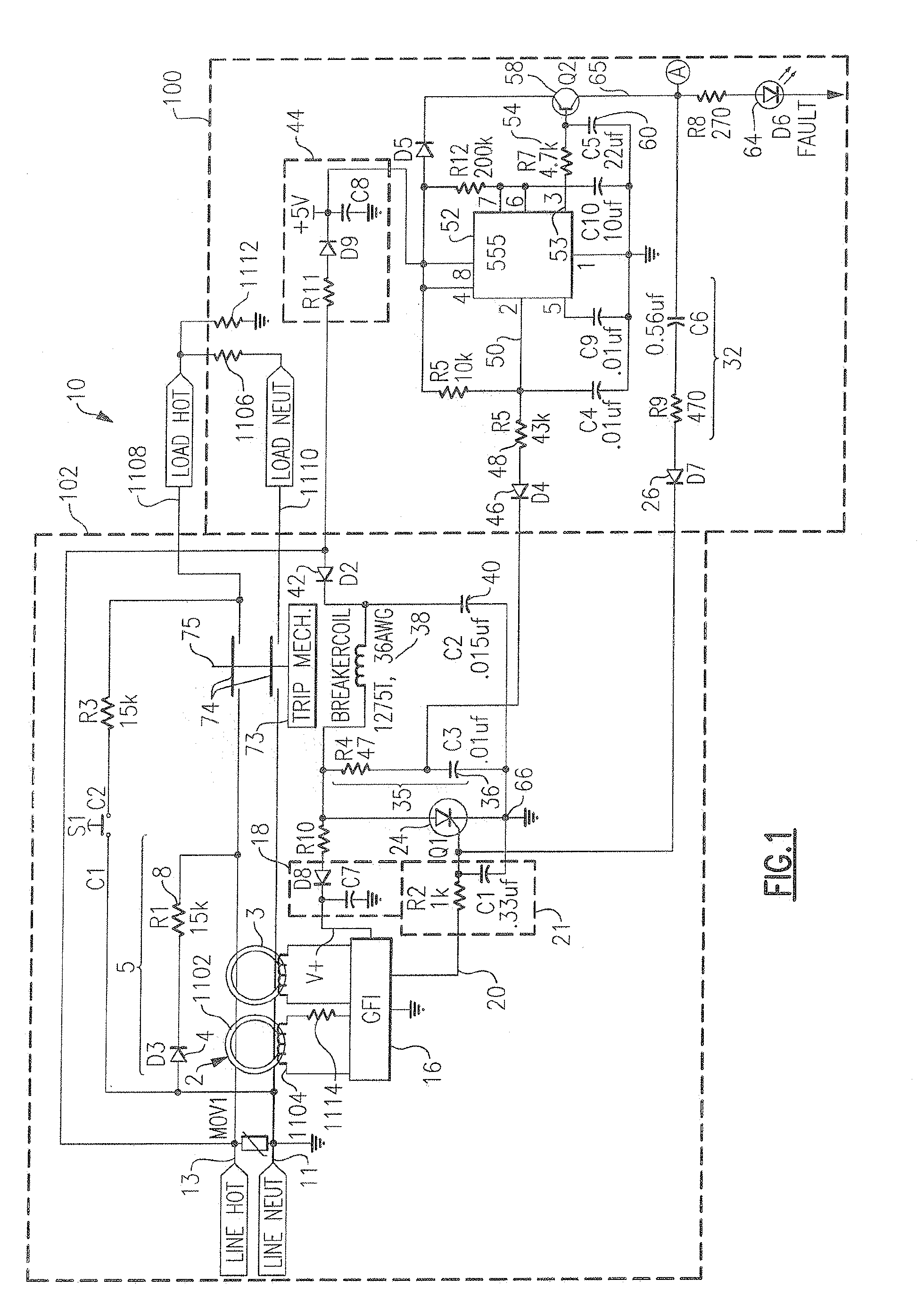Protective device with automated self-test
a protection device and self-test technology, applied in the direction of circuit-breaking switches, testing circuits, instruments, etc., can solve the problems of protective devices permanently denying power to load terminals
- Summary
- Abstract
- Description
- Claims
- Application Information
AI Technical Summary
Benefits of technology
Problems solved by technology
Method used
Image
Examples
second embodiment
[0084]As embodied herein and depicted in FIG. 12, a schematic of a circuit protection device in accordance with the present invention is disclosed. FIG. 12 is a schematic diagram of an alternate embodiment in which the fault simulation circuit generates a simulated negative half cycle grounded neutral signal. Reference is made to U.S. patent application Ser. No. 10 / 768,530, which is incorporated herein by reference as though fully set forth in its entirety, for a more detailed explanation of the fault simulation signal. Note that test circuit 1128 does not include diode 4.
[0085]The GFI circuit 102 in FIG. 12 includes a transformer 2 that is configured to sense a load-side ground fault when there is a difference in current between the hot and neutral conductors. Transformer 2 transmits a sensed signal to detector circuit 16. GFI circuit 102 also includes a grounded neutral transmitter 3 that is configured to detect grounded neutral conditions. Those skilled in the art understand that...
third embodiment
[0092]As embodied herein and depicted in FIG. 13, a schematic of a circuit protection device in accordance with the present invention is disclosed. FIG. 13 is a schematic diagram that illustrates how the present invention may be applied to a general protective device 300. Further, FIG. 13 incorporates a redundant solenoid.
[0093]If sensor 1302 is included, the protective device is an AFCI. If transformers 2 and 3 are included, the protective device is a GFCI. If sensor 1302, and transformers 2 and 3 are included, the protective device is a combination AFCI-GFCI. Stated generally, the protective device may include one or more, or a combination of sensors configured to sense one or more type of hazardous conditions in the load, or in the AC electrical circuit supplying power to the load. Sensor 1302 senses an arc fault signature in load current. Detector 1304 is similar to ground fault detector 16, but is configured to detect signals from any of the variety of sensors employed in the d...
fourth embodiment
[0120]As embodied herein and depicted in FIG. 20, a schematic of a circuit protection device in accordance with the present invention is disclosed. GFCI 10 includes a GFI circuit 102 and a self test checking circuit 2110. GFI circuit 102 includes a standard GFCI device in which a load-side ground fault is sensed by a differential transformer 2. A transformer 3, which is a grounded neutral transmitter, is used to sense grounded neutral faults. The transformer 2 output is processed by a GFI detector circuit 16 which produces a signal on output 20 that, after filtering in a circuit 21, activates a trip SCR 24. When SCR 24 turns ON, it activates a solenoid 38 which in turn operates a mouse trap device 73, releasing a plurality of contacts 74 and interrupting the load.
[0121]An across-the-line metal oxide varistor (MOV1), also commonly referred to as a movistor, may be included in the protective device such as MOV 15 to prevent damage of the protective device from high voltage surges from...
PUM
 Login to View More
Login to View More Abstract
Description
Claims
Application Information
 Login to View More
Login to View More - R&D
- Intellectual Property
- Life Sciences
- Materials
- Tech Scout
- Unparalleled Data Quality
- Higher Quality Content
- 60% Fewer Hallucinations
Browse by: Latest US Patents, China's latest patents, Technical Efficacy Thesaurus, Application Domain, Technology Topic, Popular Technical Reports.
© 2025 PatSnap. All rights reserved.Legal|Privacy policy|Modern Slavery Act Transparency Statement|Sitemap|About US| Contact US: help@patsnap.com



